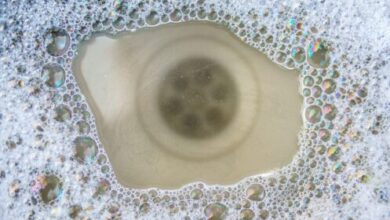What is Reverse Osmosis Water Filtration?


You probably don’t give it much thought when you grab a glass of tap water, but there’s often more in it than you expect. Things like chlorine and small particles of sediment can still be present, even in treated water. That’s where reverse osmosis comes in. It’s a multi-step filter that uses pressure to pull out the small stuff other filters leave behind. At Rosenberg Plumbing & Air, in San Antonio, TX, we help homeowners install and maintain these systems so they can feel confident about the water coming out of every faucet.
What Makes Reverse Osmosis Different From Other Filters
If you’ve ever bought a pitcher filter or attached something to your faucet, you already know the basics of water filtration. Most standard systems work like a sponge. Water flows through a material that grabs larger particles or chlorine. Reverse osmosis works differently. Instead of absorbing particles, it separates them.
In a reverse osmosis system, water gets pushed through a super-thin filter called a semipermeable membrane. Only tiny water molecules make it through while bigger stuff, like salts, fluoride, nitrates, and metals, gets left behind. Pressure helps keep everything moving, so the filter doesn’t clog up. And before it hits your glass, the water goes through a few different layers to catch anything that might have slipped past earlier on.
Why Your Water Might Still Contain Contaminants
Municipal water goes through chemical treatment to remove pathogens, but it also travels through long stretches of pipe before reaching your home. During that trip, it can pick up minerals, rust, and sediment from aging infrastructure. Chlorine might linger, too, and although it helps keep water safe while in transit, it often affects smell and taste.
If you use well water, there’s an entirely different set of risks. Groundwater pulls in runoff from fields, nearby construction, or septic systems. That runoff may carry fertilizer, bacteria, or organic material. Because well water is not treated in the same way as city water, the full responsibility for filtering it falls on you. Even with a softener, you might still notice hardness, staining, or cloudiness. Reverse osmosis helps clear out those fine particles and dissolved solids that slip past other setups.
Understanding the Layers in a Reverse Osmosis System
Most systems start with a pre-filter. This stage catches larger debris like sand, rust flakes, or silt that would otherwise clog the membrane. After that, water often passes through a carbon filter. This step helps reduce chlorine and volatile organic compounds, which can damage the membrane or leave behind odors.
Then comes the heart of the system, the semipermeable membrane. It is designed to trap particles as small as 0.0001 microns. That’s small enough to catch lead, arsenic, and microplastics. After the membrane, some systems include a post-filter, usually another layer of carbon. That stage helps polish the water and improve its taste. The final result is cleaner water that feels lighter, smells neutral, and has fewer impurities than you’d get from tap or most basic filter options.
Signs Your Water Could Benefit From Reverse Osmosis
Some signs are subtle. If your drinking water has a slightly metallic, bitter, or earthy taste, that might mean minerals or contaminants are slipping through. If your ice cubes come out cloudy or you see white streaks in your kettle or coffee maker, dissolved solids are likely present.
Other signs are more visible. Red or brown stains in sinks and tubs could point to iron. Blue or green stains might mean copper is leaching from pipes. Even persistent water spots on dishes or glasses might suggest your supply has a high dissolved solids count. These issues are often harder to solve with a single-stage filter. Reverse osmosis handles a wider range of contaminants and helps reduce the load that causes those stains and odd flavors.
What Happens to the Contaminants Removed
One question many people have is where everything goes once it’s removed from the water. Unlike a pitcher filter that traps particles inside, a reverse osmosis system flushes rejected contaminants down the drain. The membrane holds back the unwanted materials while clean water passes through, and then the system uses a small amount of water to rinse the concentrated waste away.
This process does create what’s called “wastewater,” but most systems are designed to limit how much is used. Newer models include flow restrictors and backflow preventers to improve efficiency. While the system uses more water than a pitcher, the result is significantly cleaner water with fewer impurities.
How Reverse Osmosis Improves Cooking and Cleaning
When you cook with filtered water, you avoid transferring minerals or chemicals into your food. That makes a noticeable difference with pasta, rice, coffee, or tea. Boiled water tastes better and leaves fewer deposits behind in your pots and pans. The clarity and flavor are stronger because nothing extra is competing with the ingredients.
Reverse osmosis water also makes cleaning easier. Glassware dries without spots, faucets develop less scale, and appliances that heat water, like kettles or steamers, stay cleaner longer. If you have a pet, their water bowl stays clearer, too. Even your plants might appreciate the change, especially if your tap water has a high mineral content that stresses sensitive species.
Maintenance Tips to Keep the System Running
A reverse osmosis system does not need much hands-on time, but you do need to stay on top of filter changes. Most filters need replacing every six to 12 months, depending on your usage and water quality. The membrane typically lasts longer, closer to two or three years, but only if the pre-filters are doing their job. If those early stages clog or degrade, the membrane wears out faster.
You’ll also want to keep an eye on water pressure. If the flow seems weaker than usual or the system makes more noise than it used to, that might be a sign that something needs replacing. Some units come with built-in indicators or monitors to help you track performance. Others need a bit more manual checking. Either way, staying ahead of these issues prevents surprises and helps your system continue to function as intended.
Deciding If Reverse Osmosis Fits Your Needs
Not every home needs reverse osmosis for every tap. In many cases, people install it at a single point, usually under the kitchen sink, where it handles drinking and cooking water. This approach works well if your main concern is taste or dissolved solids. Whole-home setups are also available, though they are more complex and usually part of a larger treatment plan for well water or older plumbing.
Before deciding, think about what you want from your water. If you just want to reduce chlorine taste, a basic carbon filter might do the job. If your concerns include lead, arsenic, nitrates, or dissolved minerals, reverse osmosis is more appropriate. You do not need to overhaul your entire setup at once. Many systems can be added gradually or combined with softeners and UV filters to build a more customized approach to your water needs.
Get Better Water at Home With Reverse Osmosis Filtration
Reverse osmosis filtration takes the guesswork out of cleaner drinking water by using precision-level filtering that goes well beyond standard options. Suppose you’re dealing with odd tastes, hard water, or concerns about what’s really in your supply. A properly installed system can make a difference.
Alongside reverse osmosis, Rosenberg Plumbing & Air also handles water softener services and filtration upgrades to help you create a safer, more reliable water setup at home. To get better water and efficient plumbing systems, get in touch with Rosenberg Plumbing & Air today.
Tags: Plumbing tips, Water filtration




